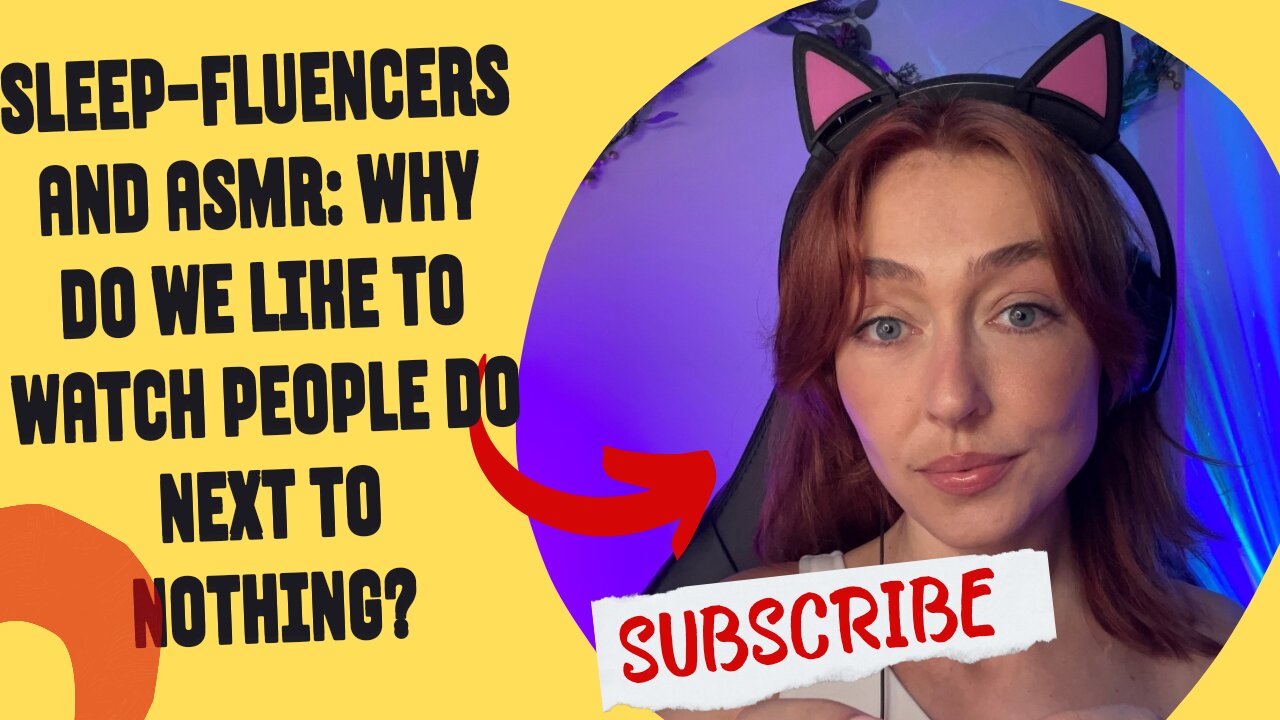Premium Only Content

Sleep-fluencers and ASMR: Why do we like to watch people do next to nothing?
Sleep-fluencers and ASMR: Why do we like to watch people do next to nothing?
Every night at 10pm, Trish lowers the lights in her home in regional Queensland, sits down and turns on her camera.
Spread out on the desk in front of her are all manner of objects, from rubber ducks to paint brushes, plush toys, and snacks — and, of course, the microphone.
For the next three or so hours, she'll live stream herself doing things that range from the mundane to the bizarre.
She might slowly eat a bag of chips, murmur incomprehensibly, or pretend to brush the viewer's hair. Everything she does is designed to create sounds that trigger the "tingles" associated with autonomous sensory meridian response (ASMR).
Right now, her favourite sound is from "wooden soup", a bowl filled with water and wooden beads.
You stir it around and the water and the clacking of the wood sounds pretty relaxing," she says.
Trish, who has more than 117,000 followers on TikTok and 10,000 subscribers on YouTube, first started live streaming in an effort to combat her long-running mental health issues.
"My therapist actually told me to get a hobby," she says.
"I'm pretty shy, I like to avoid going out, and it was my sneaky way of finding a hobby without having to actually go and interact with anyone."
Broadcasting live to thousands of strangers might seem like an unusual choice for a shy person, but Trish says it was a perfect fit.
Because I have major depression, I get a little numb and I sort of hit the 'I don't care' button," she says.
"Talking to people online is what helps me relax, I think because I enjoy helping others."
Women have told Trish they have used her videos to relax during labour, lonely teens have opened up about their need for connection, and single parents have sent her videos of their children falling asleep to her live streams.
When she does it full time, ASMR videos are Trish's primary source of income, thanks to donations from appreciative viewers, and monetisation through the platforms she uses.
So, what is it about live streaming that fascinates, relaxes or invigorates us?
The rise of the sleep-fluencer
Warren Buffet probably wasn't thinking about TikTok when he said: "If you can't make money while you sleep, you'll work until you die," but he didn't reckon on millennials.
Dan Van Boom, the technology correspondent at Capital Brief points to the recent trend of "sleep-fluencers", a relatively recent addition to the live streaming ecosystem, along with the much-talked-about NPC influencers, who stream themselves acting as non-playable characters in video games.
"There's two types of sleep-fluencer," Van Boom tells ABC RN's Download This Show.
"The type that's like visual ASMR, where, if you have insomnia, you can watch people sleeping — they just stream themselves sleeping for hours at a time."
Then there are those who "sleep" in a room "booby-trapped with various forms of hijinks", Van Boom says.
"And if you pay money, things like lights [will go on] or songs will blare to wake the sleeper up."
The sleep deprivation can go on all night, with some streamers offering more extreme wake-up methods, like electric shocks viewers can trigger if they pay enough.
This interactive kind of video, which reportedly earned one Australian creator $50,000 a month, speaks to some of our most innate psychological desires, according to Vasileios Stavropoulos, an associate professor of clinical psychology at RMIT.
The experience of [seeing] someone who is in a vulnerable moment and is suffering [while] I'm not in that position is something that relates to a very primitive kind of instinct," he says.
"We all have a basic need to feel superior or more 'normal' compared to others."
But Professor Stavropoulos says the live streaming medium can also offer an "enhanced" sense of connection and a community, though it's often a commercialised one.
"It's a whole ecology," he says.
"In the past, we used to say reality/virtuality and real life/online life, but now we know that the two intersect."
Edith Hill, an associate lecturer in the Centre for Innovation in Learning and Teaching at Flinders University, agrees.
"[Live streaming] is a new human experience," Dr Hill says.
"The world has changed so significantly in the last few years, with COVID and the political climate, it feels like we're in this very strange space. I think people are seeking out connections and different ways to experience things."
An industry worth billions
Regardless of our motivations for watching live streamers, the data bears out one thing with certainty: we want more.
Live streaming has become one of the most popular types of video content consumed online, reaching almost 28 per cent of all internet users as of March this year.
Meanwhile, the global live streaming market grew more than 20 per cent from 2022 to 2023 and is tipped to reach $US3.2 billion ($5 billion) by 2027.
Watching strangers online is, by now, a well-established trend, Dr Hill explains.
While sex workers have been using live streams, known as camming, since the 1990s, it was the advent of YouTube in 2005 — and its first live stream in 2008 — that launched the format into the mainstream.
At that point, Dr Hill says, reaction videos, where people filmed themselves or others responding to something funny, disgusting, embarrassing or joyful, dominated the medium — and were an extension of existing human behaviour.
"[People-watching] is a phenomenon outside of the internet era.
"Everyone likes to people-watch on the street and overhear conversations. That reaction video space is where a lot of this came from ... then it's kind of spread and split out into all of these really niche subgenres."
Over time, popular platforms for live streaming, like YouTube, Twitch, TikTok, Facebook and Kick, have offered different monetisation options that vary around the world and include subscriptions, advertising and gifts.
But for those considering a career switch into live streaming, Dr Hill warns it isn't as lucrative as headlines might imply.
In fact, those making videos on TikTok are generally earning about 4 cents per 1,000 views, and the platform also takes a cut of gifts viewers give.
"The people who are actually making a lot of money are in the vast minority," Dr Hill says.
"You see moral panic headlines like, 'Pinkydoll makes millions of dollars pretending to be a video game character' but that's one in a million people."
Trish might not be making millions of dollars live-streaming, but she says "as long as people keep watching and wanting to support, I am more than happy to keep going".
She used to wonder, "Why are people watching me? Why are people gifting me?
"[But] I think … everyone just wants a little bit of peace."
-
 8:27:46
8:27:46
Sm0k3m
10 hours agoPlaying games on Rumble
30.6K2 -
 10:37
10:37
Russell Brand
2 days agoHow is this even allowed?
178K837 -
 1:37:26
1:37:26
Real Coffee With Scott Adams
7 hours agoEpisode 2701 CWSA 12/26/24
96.7K86 -
 2:58:58
2:58:58
Wendy Bell Radio
11 hours ago9 Steps Ahead
124K139 -
 2:03:46
2:03:46
LFA TV
20 hours agoTIME FOR A NEW SPEAKER! | LIVE FROM AMERICA 12.26.24 11am EST
73.2K46 -
 1:40:22
1:40:22
Game On!
17 hours ago $5.49 earnedNFL Thursday Night Football Seahawks at Bears EXPERT Picks!
53.7K9 -
 1:50:54
1:50:54
xBuRnTx
7 hours agoWho's Ready for New Years!
39.8K1 -
 12:09
12:09
Tactical Advisor
19 hours agoSmith & Wesson Shield Plus Carry Comp
32.6K2 -
 4:35:25
4:35:25
Father Russell
12 hours agoDelta Force | Not A Woman? | Mad Martigan Time
71.7K5 -
 3:29:42
3:29:42
BrookieMonster
19 hours ago $45.01 earnedChristmas Stream: Marvel Rivals with CallmeSeags 🎄
189K13